Some Interior Design Rules You Should Know, just so you can break them beautifully.
There’s something strangely comforting about having rules to follow.
They make things feel less chaotic, like someone quietly showing you where the sofa should go or which colors won’t clash.
It’s like being handed a little map when you’re standing in the middle of a maze of design choices.
But here’s what no one really says out loud: following all the rules doesn’t always make a place feel like home.
I only learned that after a really rough patch in my life. A big move. A painful breakup that shattered more than just my heart and left my heart in more pieces than my furniture.
Starting over felt necessary, so I did what a lot of us do. Look for answers.
I read blogs, saved some Pinterest inspiration, followed every bit of expert advice I could find. Yunoo, I just wanted to get it right this time.
At the end, I matched the tones, picked out calming colors, bought the soft, neutral curtains everyone swears by.
And when it was all done?
The room looked good. So good.
But it didn’t feel like mine.
It felt like a space waiting for someone else to move in.
Then one night, without thinking too much, I took those curtains down. And putted up a pair I had packed for months.
A curtain I secretly loved but never thought I should hang.
And that simply changed everything.
That moment reminded me that design isn’t just about sticking to the right rules, it’s about following your rhythm.
The spaces we truly fall in love with, usually come from breaking a few of those rules, but with purpose
So, in this post, I’ll walk you through the design foundations that do help a room work and also spot the moments where it’s okay to bend or break those rules a little.
Because at the end of the day, great design isn’t about perfection. It’s about presence.
The Foundations — Basic Interior Design Rules That Work Every Time
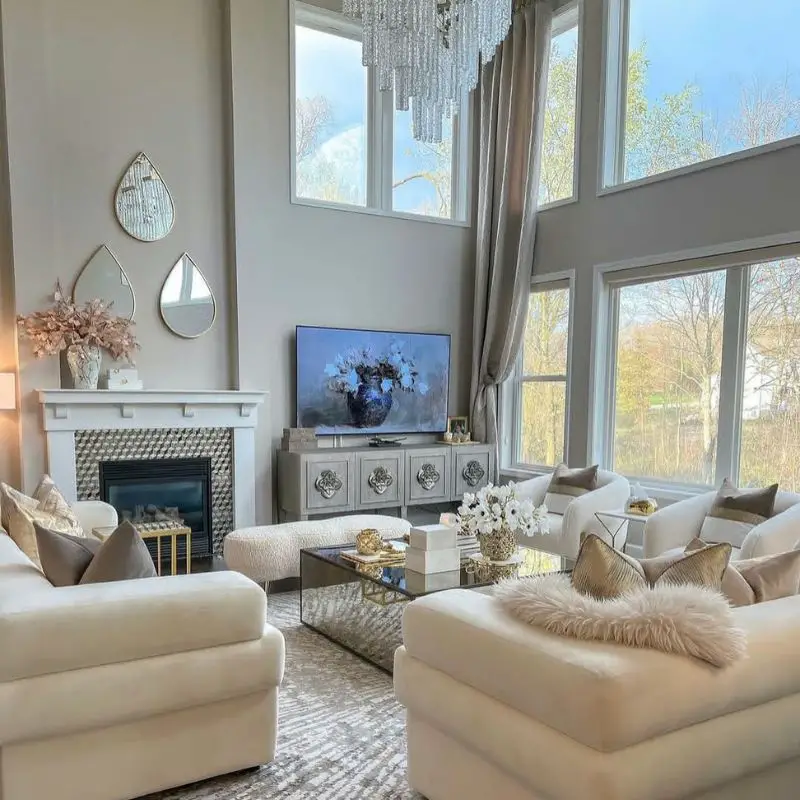
Photo credit @ inspire_me_home_decor
When I first started decorating, I kept asking myself, “Why doesn’t this look right?” I’d move things around ten times.
I tried one rug, then another. I followed all the tips I saw online, I knew what I wanted and I knew I did have it just yet.
If this your ordeal as well, you’re not alone.
Interior design can feel like a guessing game. But there are a few simple rules that can help.
-
Balance and Proportion
Think of balance like the quiet feeling you get when a room just feels right, where nothing’s screaming for attention and everything works together.
Proportion is about making sure the pieces in a room feel like they belong together in size.
A huge couch and a tiny coffee table? That might throw things off. But when the sizes make sense together, the room feels more grounded.
When You Might Break It:
Sometimes, a little imbalance is exactly what a room needs like an oversized piece of art above a small console, or a dramatic lamp that takes up more space than it should. If it brings personality or drama in a way that speaks to you, let it.
-
Scale and Harmony
Scale is like a cousin to proportion, it’s about how big or small things are in a space, especially in relation to each other. Harmony is how everything flows together visually, say colors, styles, and shapes.
Stick with similar shapes or colors, and your room feels calm. Mix too many clashing pieces, and it starts to feel chaotic.
Harmony is what helps your eyes relax in a room. It’s what makes a space feel pulled together, not random.
When You Might Break It:
Boho or eclectic styles love to mess with harmony. You can throw together textures, colors, and patterns from totally different worlds and somehow, it works.
If your personality is more wildflower than white-wall, break this one freely.
-
Function Before Aesthetics (But Never Forget Beauty)
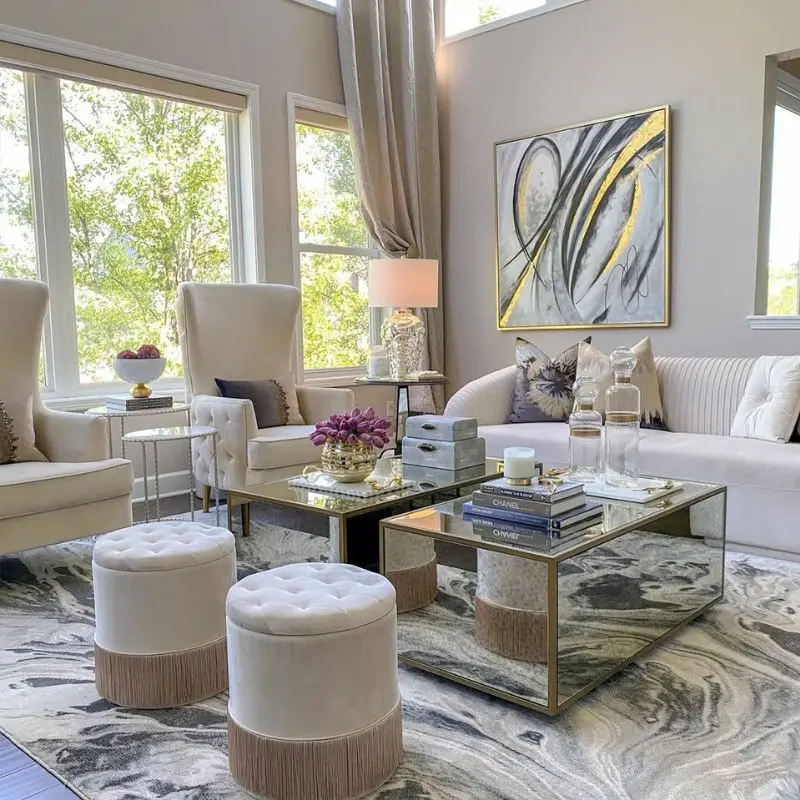
Photo credit @ inspire_me_home_decor
Your space should work for you. That’s the rule. Your sofa shouldn’t just look good, it should be comfortable.
Your lighting shouldn’t just be pretty, it should help you see. If it’s beautiful but useless, you’ll grow to resent it.
But here’s the thing: beauty matters too. A space that’s only functional can feel cold or unfinished.
So yes, function comes first, but don’t forget to sprinkle beauty everywhere.
When You Might Break It:
In moments that are purely for joy. That velvet chair that’s not super practical? If it makes you happy every time you walk past it, that’s reason enough.
Not everything has to earn its place with logic.
-
Color Coordination and Rhythm
Most designers swear by color rhythm, repeating the same colors (in different shades or accents) throughout your space so your eye can travel without feeling lost.
It makes the room feel pulled together, not like a bunch of random styles were thrown in all at once.
One classic way to do this? The 70-20-10 rule: 70% main color, 20% secondary color, and 10% accent color. It’s safe, and it works.
When You Might Break It:
Some spaces are made to break color rules. Gallery walls, kids’ rooms, creative studios, they thrive on color chaos.
And in a bedroom or reading nook that’s just for you? Go ahead and throw the rules out the window. Your space doesn’t have to make sense to anyone but you.
The 7 Basic Principles of Interior Design
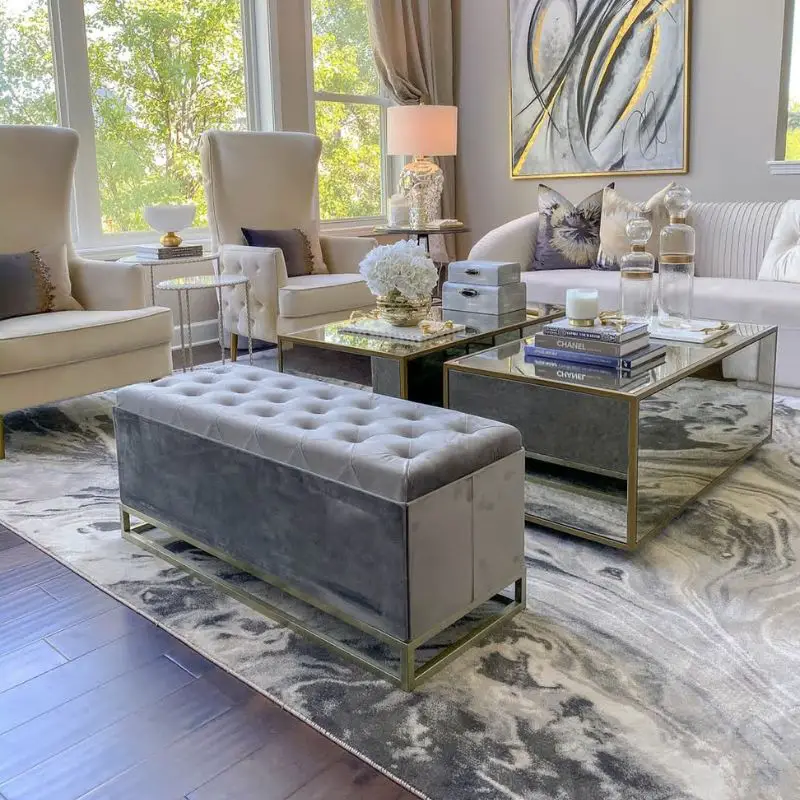
Photo credit @ inspire_me_home_decor
Decorating a home can feel like a puzzle. You buy things you love, but when you put them together, sometimes, it just doesn’t quite click.
Maybe the room feels too empty, or a little too busy.
That’s where the 7 principles of design come in. They’re not just for designers or fancy magazine spreads.
These are quiet little helpers that can turn a space from not quite right to just right.
Let’s break them down with simple words, real-life examples, and the honest truth about when it’s okay to ignore them.
-
Balance
Sometimes when you walk into a room, it just doesn’t feel right. Maybe one side feels heavy with all the big furniture like the couch, bookshelf, and armchair, while the other side feels empty and sad.
That’s a common problem with balance. Your room should feel even, not like it’s tipping over on one side.
To fix this, try adding something to the emptier side, like a floor lamp or a big plant. Or maybe move things around so the weight spreads out better.
But hey, if you want to create a bold, uneven look, like a cozy reading corner packed with layers, go for it! Just make sure it looks like you planned it, not like you forgot to finish decorating.
-
Contrast
This is all about mixing things up so your space doesn’t feel dull. If your whole room is one soft neutral color with matching furniture, it can feel a bit flat.
But bring in a black picture frame on a white wall, or mix soft cushions with a rough wooden table, and suddenly the room feels alive.
You can start small with pillows, rugs, or art that adds a pop of difference.
If you really love calm, soft colors all around, that’s cool too, just try to play with textures like velvet and linen to keep it from feeling boring.
-
Rhythm
Rhythm might sound fancy, but it’s just about repeating things so your eye can move around the room easily.
For example, if you have navy blue cushions on your couch, try to bring that color back somewhere else, maybe a vase or a piece of art on the wall.
It ties everything together without feeling too matchy-matchy.
Pick one or two things to repeat, like a warm wood tone or a splash of yellow, and you’ll feel the flow.
But if your space is meant to feel wild and creative, like a kid’s playroom or a studio then it’s okay if rhythm takes a back seat. Let it be a little messy and personal.
-
Emphasis
Every room needs something to catch your eye first, like a star on a stage. Usually, the bed is the star in a bedroom, or maybe a fireplace or a big art piece in the living room.
Pick that main thing and make sure other stuff doesn’t fight for attention. Give your star some breathing room so it shines.
If your place is small or has lots of uses, like a studio apartment, you might not have one clear star, and that’s okay too. Use lighting or furniture placement to create soft focus spots instead.
-
Scale and Proportion
Scale and proportion are about size, making sure things in your room feel like they belong together.
A tiny rug under a huge sofa looks odd, and so does a giant coffee table in a cramped space.
Measure before buying new pieces, or rearrange what you have. Maybe that oversized chair would work better in a corner where it has space to stand out.
Sometimes though, breaking the rule works, a big mirror or a huge lamp can become a piece of art if the rest of the room is simple and airy.
-
Harmony and Unity
These two are everything in the room feels like it belongs. You don’t have to have everything match, but it should feel connected, maybe through a color or material that shows up in different places.
If you have a mix of modern and vintage pieces, ask yourself if they tell the same story. If not, try moving things or swapping out what feels out of place.
That said, mixing big contrasts can be amazing when it’s done on purpose, like a rustic wooden stool in a sleek modern kitchen, if it means something to you, its part of the harmony.
-
Functionality
Last but definitely not least, functionality is key. Your space should work for how you live, not just look nice.
A beautiful sofa that’s uncomfortable, or a coffee table you keep hitting your shin on, isn’t helping anyone.
Think about your life, do you have kids or pets? Do you love hosting friends?
Let those things guide your choices, from what fabrics you pick to how you arrange the room. You don’t have to be a slave to function, though.
Sometimes it’s okay to have one pretty thing that’s just for looking at, like a delicate vase placed somewhere safe. The trick is to balance beauty with how you actually use your space.
Interior Design Elements and Principles

Photo credit @ inspire_me_home_decor
When you start thinking about decorating your home, it’s easy to get overwhelmed by all the choices.
That’s why knowing some interior design rules you should know really helps.
Among the most important are the basic elements and principles of design. These are the building blocks that make any room feel like it belongs together.
First, let’s talk about the key elements. Think of them as the raw materials you have to work with:
- Space is the area you have to fill. It’s not just empty; it’s what gives your furniture and decorations room to breathe.
- Line means the edges and shapes you see, like the straight lines of a table or the soft curves of a chair.
- Form is about the 3D shapes, something round, square, tall, or short.
- Light is super important. It can change how colors look and even how big or small a room feels.
- Color sets the mood, imagine calm blues, happy yellows, or bold reds all say something different.
- Texture is how things feel or look like they would feel, like soft cushions or rough wood.
- Pattern adds personality, if it’s stripes on a rug or flowers on a pillow.
Now, these elements don’t work alone. They need to follow certain principles to come together nicely.
Things like balance, rhythm, and harmony help the room feel peaceful and connected.
When you combine these elements with the right principles, your space feels like it makes sense, like everything belongs.
Let me give you a quick example say, a living room. Imagine a serene spot with a soft rug (texture and pattern), a comfy sofa (form and color), natural light pouring in through the window (light), and enough space so you’re not tripping over furniture (space).
The lines from the furniture guide your eye around, and the colors repeat in pillows and artwork to create rhythm.
It feels welcoming because all those pieces work together, not by accident, but because they follow the interior design rules you should know.
So when you’re next planning your room, think about these elements and principles.
They aren’t strict laws, but more like a helpful map that guides you to a home that looks great and feels right.
Once you understand them, you’ll find it easier to know when to stick to the rules, and when to let your own style take the lead.
The 70-20-10 Rule in Interior Design
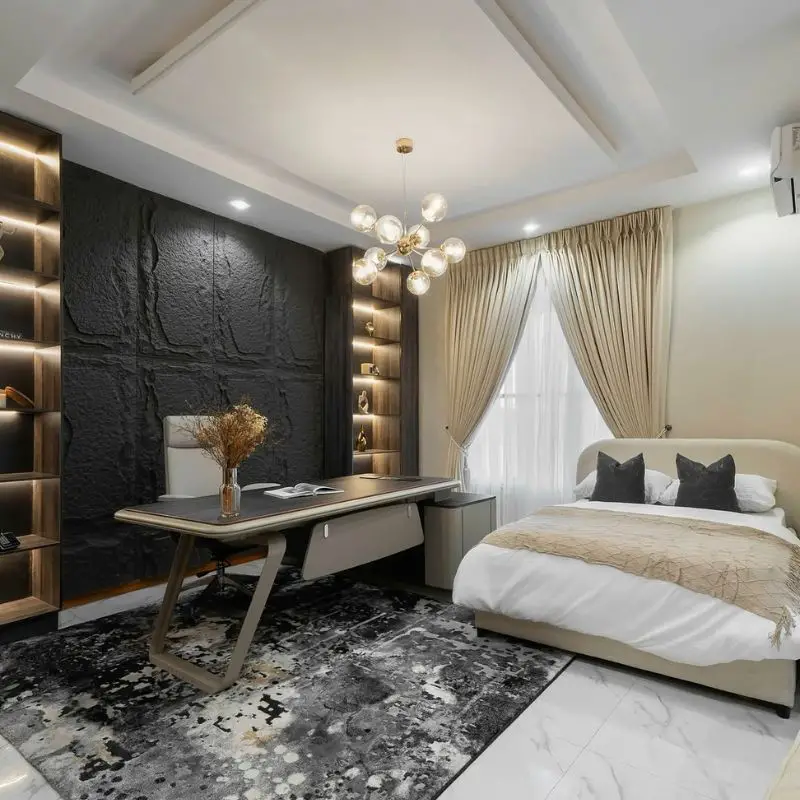
Photo credit@- li_interiors
Picking colors for a room can feel tricky. You want your space to look good but also feel balanced, not too plain, not too loud.
That’s where one of the interior design rules you should know really helps: the 70-20-10 rule. It’s a simple color formula that brings both calm and character into a space.
Here’s how it works: 70% of your room’s color should be your main, dominant color.
This could be the walls, the sofa, or any large furniture pieces. Then, 20% is your secondary color, maybe a rug, chair, or curtains that add variety without taking over.
And the last 10%? That’s your accent color, those small but bold touches like pillows, vases, or artwork that draw the eye and add life.
While this is one of the most useful interior design rules you should know, it’s not a rule that can’t be bent.
Sometimes, going off-script makes your space feel more like you.
A modern, minimal home might lean 90% white with just a hint of black. An artsy space might be bursting with color in unexpected ways.
Use the 70-20-10 rule when you need a solid starting point, but always leave room to follow your gut.
At the end of the day, your home should reflect your style, not just a formula.
The Golden Rule in Interior Design
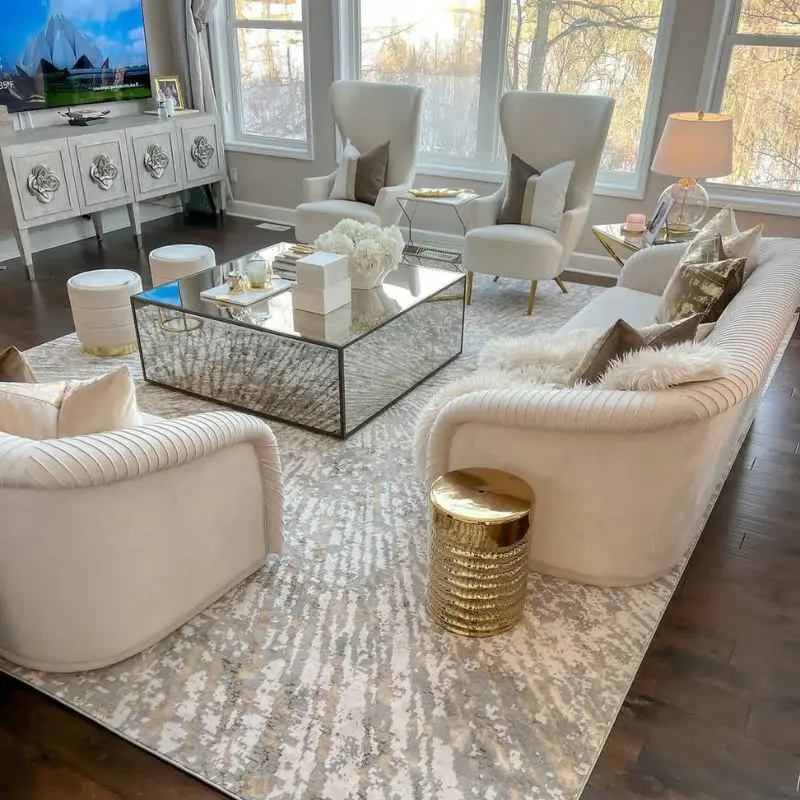
Photo credit @ inspire_me_home_decor
One of the most important interior design rules you should know is what many call the golden rule: let the room speak first.
What that means is, before you start buying furniture or picking colors, really pay attention to the space itself.
Look at the shape of the room, the windows, the doors, how light moves through during the day. The architecture and function of the room should guide your choices.
For example, a room with big windows might not need heavy curtains, or a small awkward space might work better with furniture that fits the flow rather than bulky pieces.
Sometimes, the best rule is to be flexible adapt your plan based on what the room is telling you.
When you listen to the room first, your design feels natural and comfortable, not forced.
So even though there are plenty of interior design rules you should know, this golden one reminds us that every space is different, and the best interiors come when you honor what the room needs before anything else.
When to Break the Rules (And Still Get It Right)
Sometimes, the best spaces are the ones that don’t follow every rule to the letter.
You can break the rules in interior design and still end up with a room that feels amazing, as long as you do it on purpose, not by accident.
The trick is knowing which rules are more like gentle suggestions, and which ones are actually holding the room together.
Let’s say you’ve read all about balance and matching furniture, but then you see a dining room with completely different chairs around the table, and somehow it looks stylish, not messy.
Or maybe you’ve heard you should keep ceilings light and simple, but someone paints theirs a deep navy blue, and it works beautifully.
These are great examples of rule-breaking done right.
So how do you know when you can push the boundaries? Start by thinking about the feeling you want your space to give.
If you’re after something playful, moody, or deeply personal, it’s totally fine to bend a few traditional ideas, like mixing bold patterns or using high-contrast colors in unexpected places.
One of the interior design rules you should know is that some guidelines are there to help you start, not finish.
You don’t have to follow them forever. Trust your gut, keep things intentional, and always check if the room still feels put-together, even when you’re doing something a little different.
If it feels off, adjust until it feels right. That’s where the real creativity comes in.
Breaking the rules isn’t about being random. It’s about making choices that mean something to you. And that’s what turns a house into a home.
Leave a Reply